Experimental Study of the Effect of Ultrasound on the Freezing Process of Bo Chinh Ginseng
Abstract
1. Introduction
2. Materials and Methods
2.1. Experimental Material
2.2. Experimental Equipment
- Freezing-room dimensions: 450 × 450 × 500 (mm).
- Cascade refrigeration system:
- + Compressors of the 1st and 2nd stage (model: CAJ2464Z; manufacturer: Tecumseh; made in Selangor, Malaysia).
- 4.
- Ultrasound frequency generator (model: CDEXIM0620; frequency: 20 kHz; manufacturer: Conprofe Technology Group Co., Ltd.; made in Guangdong, China).
2.3. Measurement Equipment
2.3.1. Temperature Measurement
2.3.2. Color Measurement
2.3.3. Microscopic Capture of Material Surface Structure via SEM (Scanning Electron Microscope)
2.4. Experimental Procedure
2.5. Experimental Method
- Experiment 1: experiment on how ultrasound irradiation with a power of 0, 50, 100, 150 and 200 W at a 20 kHz frequency influences the material freezing time and nucleation temperature of water in the material.
- Experiment 2: experiment on how the irradiation temperature affects the nucleation temperature of the material.
- Experiment 3: experiment on how the rate of transmitting intermittency affects the freezing time.
3. Results and Discussions
3.1. Experimental Effect of Ultrasound Power on Freezing Time of Bo Chinh Ginseng
3.2. Experimental Effect of Ultrasound Power on Nucleation Temperature during Freezing of Bo Chinh Ginseng
3.3. Effect of Ultrasound Initiation Temperature on Nucleation Temperature during Freezing of Materials
3.4. Experimental Effect of Interruption Rate on Freezing Time of Bo Chinh Ginseng
3.5. Effect of Ultrasound Irradiation on the Color of Materials after Freezing
3.6. Experimental Effect of Ultrasound Irradiation on the Microstructure of Bo Chinh Ginseng
4. Conclusions
Author Contributions
Funding
Institutional Review Board Statement
Informed Consent Statement
Data Availability Statement
Conflicts of Interest
References
- Kapoor, N.; Mohite, A.M.; Sharma, N.; Sharma, D. Comparative analysis of freeze-dried and spray dried beet-root powder according to physico-chemical, functional and color properties. Bull. Transilv. Univ. Brasov. Ser. II For. Wood Ind. Agric. Food Eng. 2021, 14, 153–162. [Google Scholar] [CrossRef]
- Heldman, D.R.; Daryl, B.L. Handbook of Food Engineering, 3rd ed.; CRC Press: Boca Raton, FL, USA, 2019. [Google Scholar] [CrossRef]
- Ma, X.; Mei, J.; Xie, J. Mechanism of ultrasound assisted nucleation during freezing and its application in food freezing process. Int. J. Food Prop. 2021, 24, 68–88. [Google Scholar] [CrossRef]
- Chow, R.; Blindt, R.; Chivers, R.; Povey, M. A study on the primary and secondary nucleation of ice by power ultrasound. Ultrasonics 2005, 43, 227–230. [Google Scholar] [CrossRef] [PubMed]
- Delgado, A.E.; Zheng, L.; Sun, D.W. Influence of ultrasound on freezing rate of immersion-frozen apples. Food Bioprocess Technol. 2009, 2, 263–270. [Google Scholar] [CrossRef]
- Islam, M.N.; Zhang, M.; Adhikari, B.; Cheng, X.; Xu, B.G. The effect of ultrasound-assisted immersion freezing on selected physicochemical properties of mushrooms. Int. J. Refrig. 2014, 42, 121–133. [Google Scholar] [CrossRef]
- Islam, M.N.; Zhang, M.; Fang, Z.; Sun, J. Direct contact ultrasound assisted freezing of mushroom (Agaricus bisporus): Growth and size distribution of ice crystals. Int. J. Refrig. 2015, 57, 46–53. [Google Scholar] [CrossRef]
- Mortazavi, S.; Tabatabaei, F. Study of ice cream freezing process after treatment with ultrasound. World Appl. Sci. J. 2008, 4, 188–190. [Google Scholar]
- Zhang, M.; Haili, N.; Chen, Q.; Xia, X.; Kong, B. Influence of ultrasound-assisted immersion freezing on the freezing rate and quality of porcine longissimus muscles. Meat Sci. 2018, 136, 1–8. [Google Scholar] [CrossRef]
- Zhang, M.; Xia, X.; Liu, Q.; Chen, Q.; Kong, B. Changes in microstructure, quality and water distribution of porcine longissimus muscles subjected to ultrasound-assisted immersion freezing during frozen storage. Meat Sci. 2019, 151, 24–32. [Google Scholar] [CrossRef]
- Zhu, Z.; Zhang, P.; Sun, D.W. Effects of multi-frequency ultrasound on freezing rates and quality attributes of potatoes. Ultrason. Sonochem. 2020, 60, 104733. [Google Scholar] [CrossRef]
- Xu, B.; Zhang, M.; Bhandari, B.; Cheng, X. Influence of power ultrasound on ice nucleation of radish cylinders during ultrasound-assisted immersion freezing. Int. J. Refrig. 2014, 46, 1–8. [Google Scholar] [CrossRef]
- Kiani, H.; Sun, D.W.; Delgado, A.; Zhang, Z. Investigation of the effect of power ultrasound on the nucleation of water during freezing of agar gel samples in tubing vials. Ultrason. Sonochem. 2012, 19, 576–581. [Google Scholar] [CrossRef] [PubMed]
- Shi, Z.; Zhong, S.; Yan, W.; Liu, M.; Yang, Z.; Qiao, X. The effects of ultrasonic treatment on the freezing rate, physicochemical quality, and microstructure of the back muscle of grass carp (Ctenopharyngodon idella). LWT Food Sci. Technol. 2019, 111, 301–308. [Google Scholar] [CrossRef]
- Xin, Y.; Zhang, M.; Adhikari, B. The effects of ultrasound-assisted freezing on the freezing time and quality of broccoli (Brassica oleracea L. var. botrytis L.) during immersion freezing. Int. J. Refrig. 2014, 41, 82–91. [Google Scholar] [CrossRef]
- Xin, Y.; Zhang, M.; Adhikari, B. Ultrasound assisted immersion freezing of broccoli (Brassica oleracea L. var. botrytis L.). Ultrason. Sonochem. 2014, 21, 1728–1735. [Google Scholar] [CrossRef] [PubMed]
- Sun, Q.; Zhao, X.; Zhang, C.; Xia, X.; Sun, F.; Kong, B. Ultrasound-assisted immersion freezing accelerates the freezing process and improves the quality of common carp (Cyprinus carpio) at different power levels. LWT Food Sci. Technol. 2019, 108, 106–112. [Google Scholar] [CrossRef]
- Zhang, C.; Li, X.; Wang, H.; Xia, X.; Kong, B. Ultrasound-assisted Immersion Freezing Reduces the Structure and Gel Property Deterioration of Myofibrillar Protein from Chicken Breast. Ultrason. Sonochem. 2020, 67, 105137. [Google Scholar] [CrossRef]
- Kentish, S.; Ashokkumar, M. The physical and chemical effect of ultrasound. In Ultrasound Technologies for Food and Bioprocessing; Feng, H., Barbosa-Canovas, G.V., Weiss, J., Eds.; Springer: New York, NY, USA, 2011; pp. 1–12. [Google Scholar] [CrossRef]
- Nakagawa, K.; Hottot, A.; Vessot, S.; Andrieu, J. Influence of Controlled Nucleation by Ultrasounds on Ice Morphology of Frozen Formulations for Pharmaceutical Proteins Freeze-drying. Chem. Eng. Process. Process Intensif. 2006, 45, 783–791. [Google Scholar] [CrossRef]
- Kiani, H.; Zhang, Z.; Sun, D.W. Effect of ultrasound irradiation on ice crystal size distribution in frozen agar gel samples. Innov. Food Sci. Emerg. Technol. 2013, 18, 126–131. [Google Scholar] [CrossRef]
- Kiani, H.; Zhang, Z.; Delgado, A.; Sun, D.W. Ultrasound assisted nucleation of some liquid and solid model foods during freezing. Food Res. Int. 2011, 44, 2915–2921. [Google Scholar] [CrossRef]
- Yang, Z.; Yang, Z.; Yu, F.; Tao, Z. Ultrasound-assisted heat pump intermittent drying of adzuki bean seeds: Drying characteristics and parameter optimization. J. Food Process Eng. 2020, 43, e13501. [Google Scholar] [CrossRef]
- Hu, S.Q.; Liu, G.; Li, L.; Li, Z.X.; Hou, Y. An improvement in the immersion freezing process for frozen dough via ultrasound irradiation. J. Food Eng. 2013, 114, 22–28. [Google Scholar] [CrossRef]
- Tu, J.; Zhang, M.; Xu, B.; Liu, H. Effects of different freezing methods on the quality and microstructure of lotus (Nelumbo nucifera) root. Int. J. Refrig. 2015, 52, 59–65. [Google Scholar] [CrossRef]
- Saclier, M.; Peczalski, R.; Andrieu, J. Effect of ultrasonically induced nucleation on ice crystals’ size and shape during freezing in vials. Chem. Eng. Sci. 2010, 65, 3064–3071. [Google Scholar] [CrossRef]
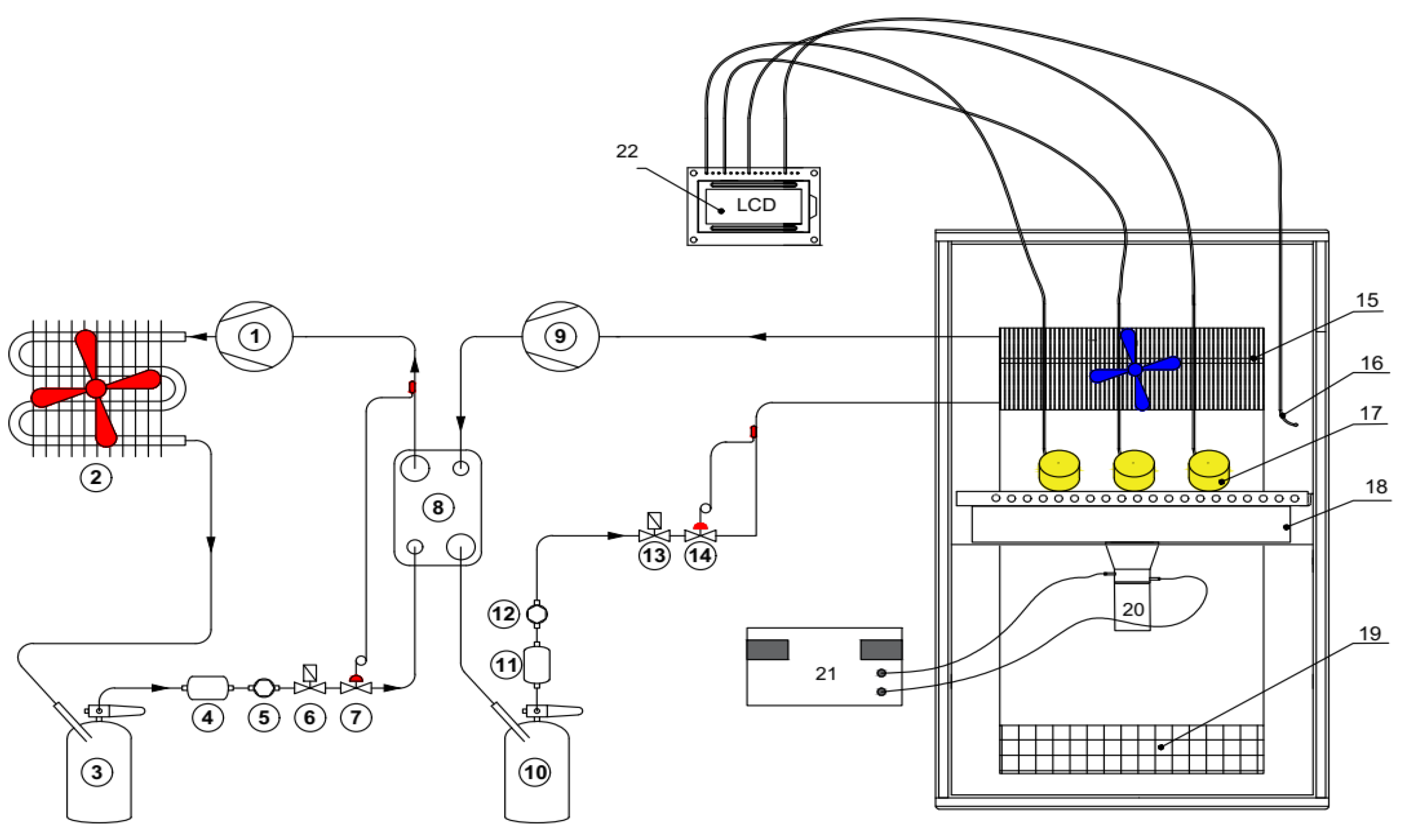
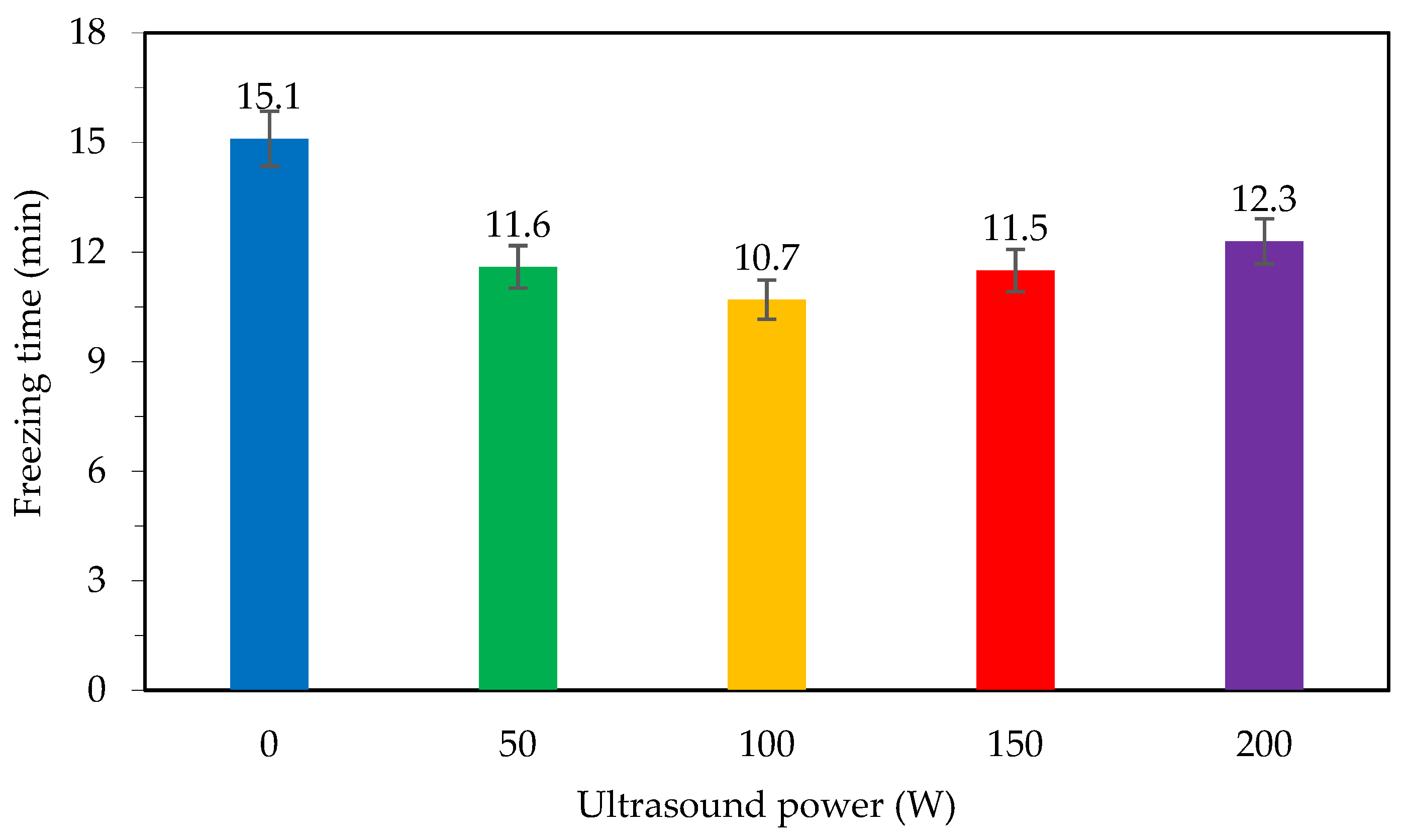

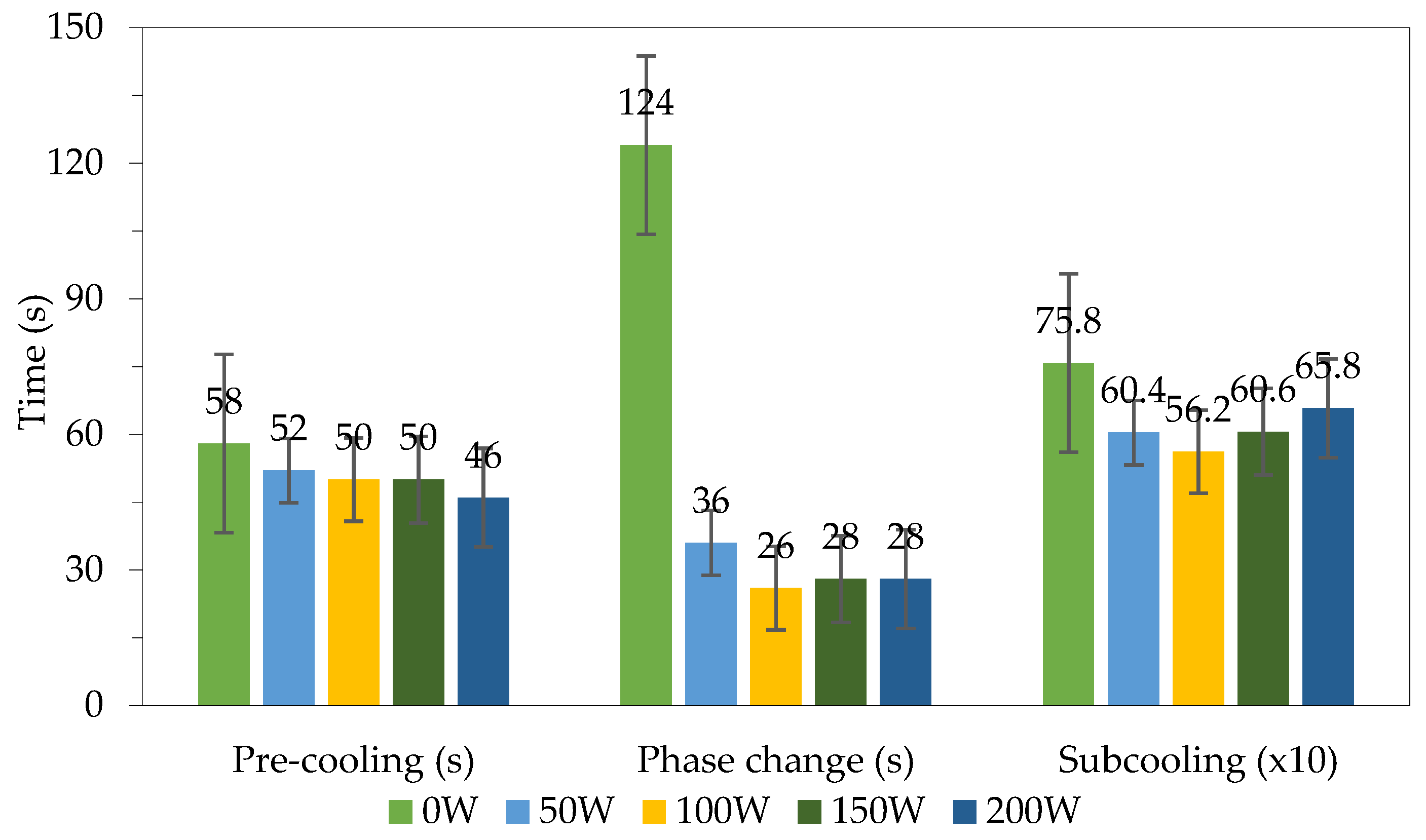


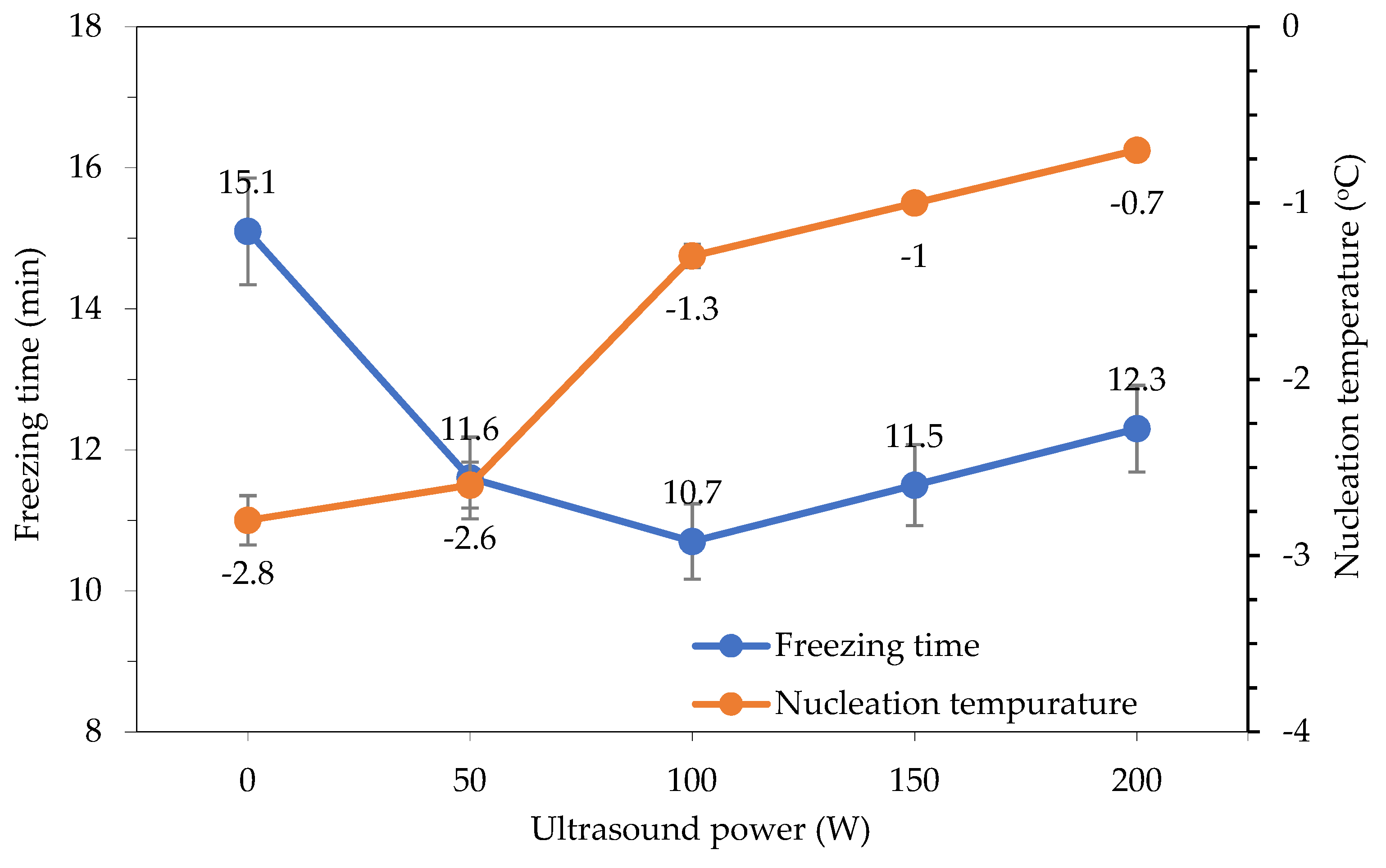

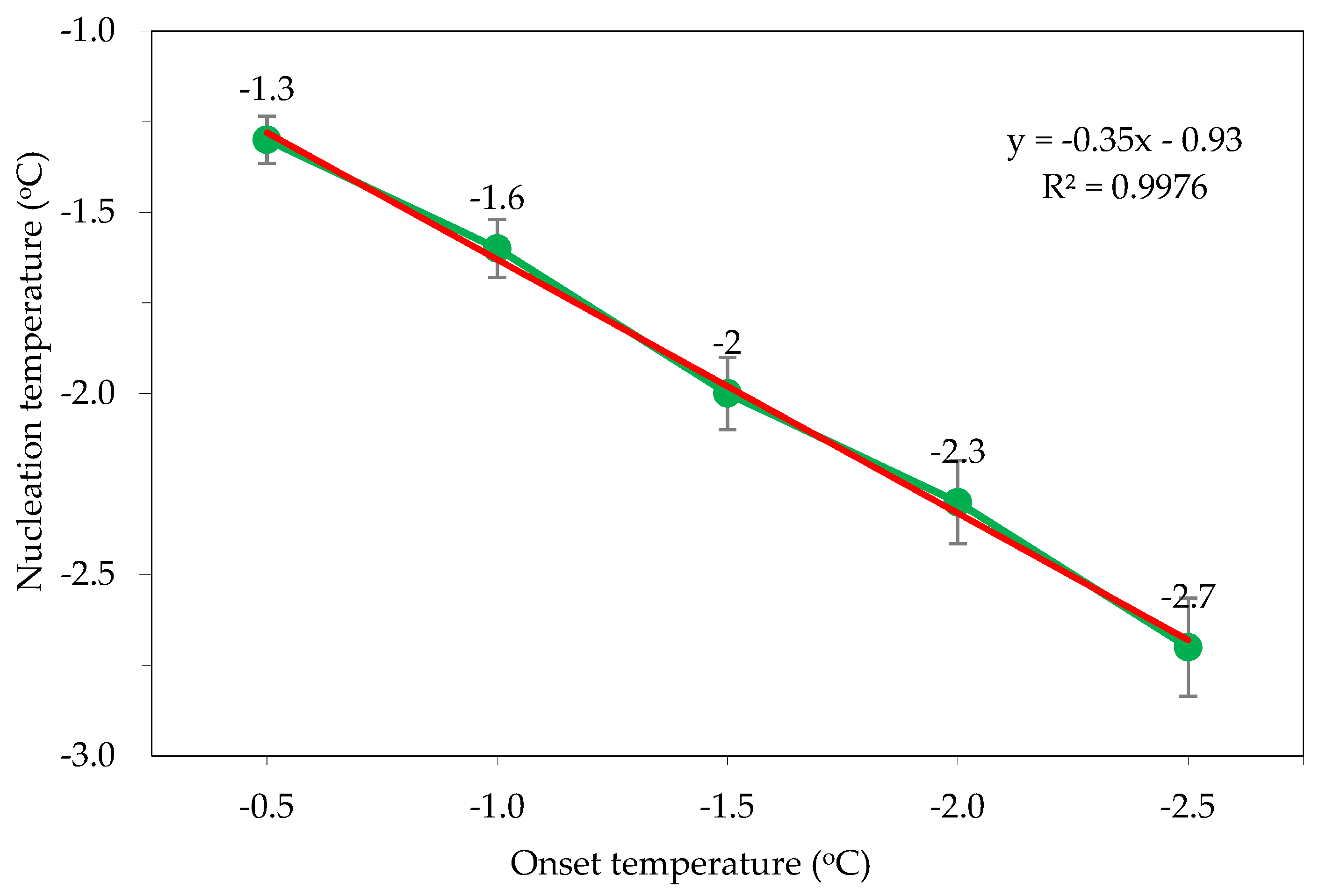

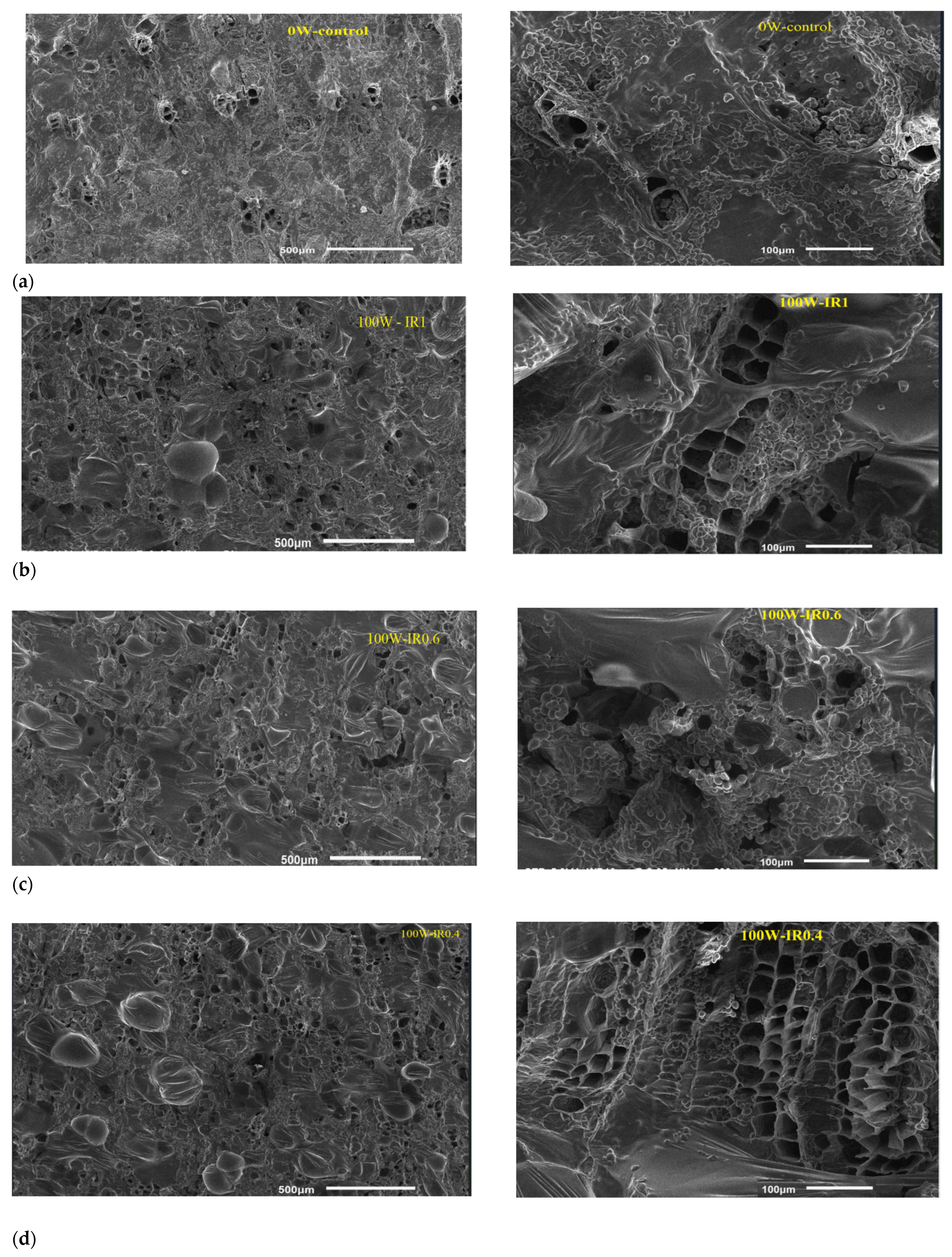
| Treatment | Control | UF-0 W | UF-100 W | UF-150 W | UF-200 W |
|---|---|---|---|---|---|
| Freezing time (s) | 15.1 | 11.6 | 10.7 | 11.5 | 12.3 |
| Nucleation Temperature (°C) | −2.8 | −2.6 | −1.3 | −1 | −0.7 |
| Treatment | L* | a* | b* | WI |
|---|---|---|---|---|
| Fresh sample | 79.65 ± 0.83 | −2.27 ± 0.09 | 9.34 ± 0.07 | 77.49 |
| Control | 86.28 ± 0.18 | 0.34 ± 0.04 | 9.62 ± 0.12 | 83.24 |
| US-100-c | 85.65 ± 0.16 | −0.44 ± 0.05 | 8.5 ± 0.26 | 83.32 |
| US-100-0.6i | 84.93 ± 0.35 | −1.17 ± 0.13 | 6.66 ± 0.24 | 83.48 |
Disclaimer/Publisher’s Note: The statements, opinions and data contained in all publications are solely those of the individual author(s) and contributor(s) and not of MDPI and/or the editor(s). MDPI and/or the editor(s) disclaim responsibility for any injury to people or property resulting from any ideas, methods, instructions or products referred to in the content. |
© 2022 by the authors. Licensee MDPI, Basel, Switzerland. This article is an open access article distributed under the terms and conditions of the Creative Commons Attribution (CC BY) license (https://creativecommons.org/licenses/by/4.0/).
Share and Cite
Ngo, M.-H.; Nguyen, H.; Nguyen, T.-B.; Le, T.-D.; Le, Q.-H. Experimental Study of the Effect of Ultrasound on the Freezing Process of Bo Chinh Ginseng. Appl. Sci. 2023, 13, 408. https://doi.org/10.3390/app13010408
Ngo M-H, Nguyen H, Nguyen T-B, Le T-D, Le Q-H. Experimental Study of the Effect of Ultrasound on the Freezing Process of Bo Chinh Ginseng. Applied Sciences. 2023; 13(1):408. https://doi.org/10.3390/app13010408
Chicago/Turabian StyleNgo, Minh-Hieu, Hay Nguyen, The-Bao Nguyen, Thanh-Dat Le, and Quang-Huy Le. 2023. "Experimental Study of the Effect of Ultrasound on the Freezing Process of Bo Chinh Ginseng" Applied Sciences 13, no. 1: 408. https://doi.org/10.3390/app13010408
APA StyleNgo, M.-H., Nguyen, H., Nguyen, T.-B., Le, T.-D., & Le, Q.-H. (2023). Experimental Study of the Effect of Ultrasound on the Freezing Process of Bo Chinh Ginseng. Applied Sciences, 13(1), 408. https://doi.org/10.3390/app13010408








